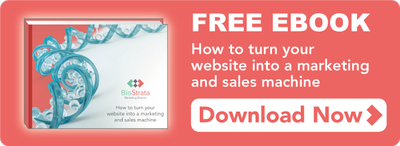We all know the importance of your website to reach buyers in this internet age, yet all too often it ends up neglected after the initial flurry of post-build activity. A website should be integral to any company’s online marketing strategy. It shouldn’t just exist. It needs to:
-
Attract visitors
-
Educate them
-
Convince them to buy.
This is the first in a series of blogs on how to turn your life science marketing website into an inbound marketing machine, and the initial step you need to take is to ensure that you can actually be found online through effective life science SEO. So, how do we work towards reaching that holy grail – the No. 1 position in search engines?
Building Inbound Links: Off-Page Search Engine Optimisation (SEO)
Off-page life science SEO is the most important factor for increasing your ranking results. This is about building your ‘authority’ by getting other quality websites to link back to you. The more inbound links you have, the more important your site is deemed to be by the search engines and therefore the higher you will rank.
Here are our top tips for off-page SEO:
- Create high-quality, educational or entertaining content. The more engaging your website content is, the more people will want to link to it so consider developing video case studies, product demonstrations, recorded training symposia, interactive games and white papers.
- Submit your website to online directories. For example, Google for Business, Bing Places for Business, SelectScience, LabCompare, BioCompare and the membership organisations your company belongs to e.g. UKSPA.
- Build a profile for your company on relevant social media channels, e.g. LinkedIn, YouTube, Patients Like Me, etc.
- Write guest posts for other blogs. Offer to develop content for third parties who will benefit from credible, quality blogs on their website that links back to your website, e.g. membership associations (e.g. BMA), suppliers, life science media (e.g. Nature) and customers.
- Investigating link-building opportunities with other websites.
- Don’t borrow, beg, barter, bribe or buy links.
On-Page SEO
On-page life science SEO is all about placing your most important keywords within the content elements of your actual pages. It is all too common for businesses to either do too little or too much on-page optimisation. These are the on-page elements you need to consider for SEO:
- Headlines
- Sub-headlines
- Body Content
- Image Tags
- Links
Here are our top tips for on-page SEO:
- Pick a primary keyword for each page. It is vital not to saturate the page with too many keywords or they will lose their importance and authority with the search engines.
- Place your primary keywords in your headline and/or sub-headline. These are the areas the search engines place the greatest importance upon.
- Include the keywords in the body content but make sure they are relevant to the rest of your content.
- Include keywords in the file name of images.
- Include the keywords in the page URL and keep the URL clean and simple.
- Most importantly, write for humans first and search engines second!
SEO is an absolute must-have for any website strategy, but it takes hard work and consistency when aiming for the top spot. These tips will help get you on your way to increasing your organic (non-paid) search engine rankings within the life science sector.
You can find out more about SEO and being found online by downloading our FREE eBook on turning your website into a marketing and sales machine.





